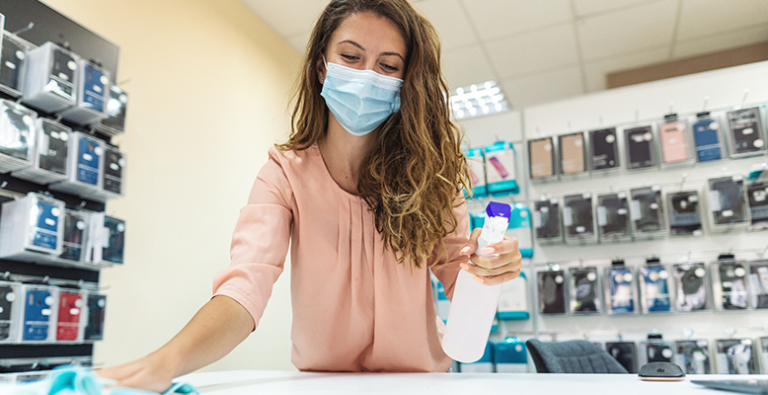The year 2020 was certainly a year of disruption in the retail industry, with COVID-19 and political unrest upsetting old operational models like never before.
After the initial wave of COVID-19, many stores radically changed store operations processes, adapting to customers’ new safety expectations. Customers drove contactless shopping methods, such as buy online pickup in store (BOPIS) and shopping by appointment. Many stores have been converting their physical layout and function to handle omnichannel distribution.
Thus far, retailers have taken steps to meet the pandemic’s challenges, updating their store operations with specialized processes that associates weren’t necessarily trained for. It also demanded new sets of safety and hygienic procedures: enforcing mask policies, establishing and maintaining social distancing policies, and boosting cleaning frequencies and thoroughness.
Retailers have worked tirelessly to remain compliant with governmental guidelines. But much of what 2021 holds is still unclear and trends seem contradictory. For instance, COVID-19 vaccinations are becoming more widespread — even as variants of the disease proliferate. Some retailers face major challenges to long-term success, while others are seeing an uptick (Lowe’s plans to go on a spring hiring spree).

In 2021, it will require extra effort for retailers to pull some of these web-centric shoppers back into brick-and-mortar stores. Customers must be convinced that visiting stores in person is safe and effortless. They need to know that retailers are closely following safety guidelines and regulations, even as they inevitably change over time.
This means that, as we navigate the late stages of the pandemic, visible safety will be paramount for shoppers in traditional retail stores. A clean, safe store, with proper safeguards and indicators, will be a crucial part of your brand.
Experts have suggested some potential factors to consider when preparing for new safety procedures this year:
- Vaccination will grow, and consumers who prefer the in-store experience will be heading back to stores, as a new RIS news article notes. This means retailers must meet the demands for safe, efficient and frictionless traditional shopping, along with BOPIS and other omnichannel-based fulfillment methods.
- With retailers investing heavily in automation, and with smart robots doing some of the more mundane tasks, associates will focus more on serving customers face-to-face and boosting the customer experience. Again, this means safety measures will be crucial.
- Customers in 2021 will demand a return to the experience-based shopping environment. This means keeping them safe, while providing them such things as data-driven shopping opportunities (special promotions and discounts) delivered and guided via mobile apps.
Empowering Safe Stores by Simplifying Store Execution
This new normal will offer continued demands to operations and safety. Are you relying on non-standardized, multichannel, undirected email or phone-based systems? Are managers and employees improvising on paper or via personal text-based messaging? These traditional, outdated, and ad-hoc systems have many potential gaps that can slow communication and the execution of critical safety procedures.
Investing in modern, mobile communications and real-time task management solutions will help you meet these new demands, bolstering any efforts to provide for customers’ evolving safety needs.
These solutions streamline store execution processes by enabling five key functions:
1. Messaging prioritization: It’s crucial that key safety messages reach the associates and managers that most need to receive them. This can involve using filters or color-coded schemes to ensure the most important safety communications and instructions are implemented as quickly as possible.
2. Management by exception: Managers should be able to immediately view the status of all safety related communications and tasks, such as a product recall or a disruptive event that might require the closure of a store or section. Managers can then proactively target any tasks or messages that appear to have been lost or not acted on.
3. Gatekeeping for emails: Headquarters should be capable of filtering through the messages and making sure the right locations and people get the right safety messages. Corporate or regional executives can ensure the tone and presentation of the communications are consistent. And they must be sure that tasks and instructions go only to those people and stores that need them, and that these communications aren’t lost in the general flurry of emails.
4. Collect feedback in-depth: Managers can create and share checklists and surveys about what store managers and employees face on the front line. For instance, do associates feel safe interacting with customers and other associates? If not, what is the best way to handle this? Collecting feedback will break down the disconnect between the office and store floor.
5. Real-time, two-way communication: As we know, situations change fast. Federal, state, and municipal agencies will continue to issue directives that demand rapid action. Crises may arise at your stores in the blink of an eye. To prevent issues caused by slow and cumbersome messaging processes, retailers can improve their operational agility by leveraging real-time communication solutions. For instance, if an employee tests positive for COVID-19 or has a high temp, the system can share this information and trigger a best-practice automated response. Associates and managers alike will receive appropriate alerts, and react as needed as quickly as possible.
We can never totally know what the future of retail will be or its safety demands. However, we can always have the solutions in place to enable successful safety communications. To learn more about how streamlining communication and store execution can prepare you for a post-pandemic future, contact us at!










